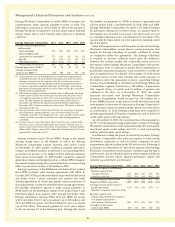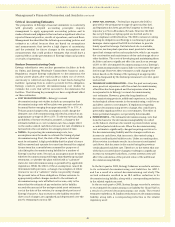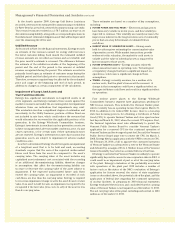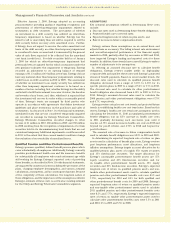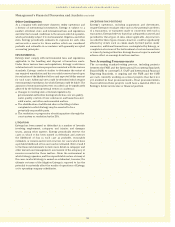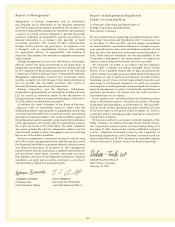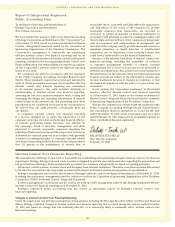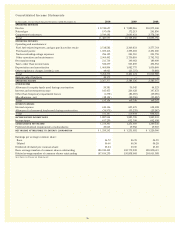Entergy 2010 Annual Report Download - page 49
Download and view the complete annual report
Please find page 49 of the 2010 Entergy annual report below. You can navigate through the pages in the report by either clicking on the pages listed below, or by using the keyword search tool below to find specific information within the annual report.
ENTERGY CORPORATION AND SUBSIDIARIES 2010
Management’s Financial Discussion and Analysis continued
to the reliability standards would result in increased capital
expenditures by the Utility operating companies.
The Entergy Regional State Committee (E-RSC), which is
comprised of representatives from all of the Utility operating
companies’ retail regulators, has been formed to consider
several of these issues related to Entergy’s transmission system.
Among other things, the E-RSC in concert with the FERC plan to
conduct a cost/benefit analysis comparing the ICT arrangement
and a proposal under which Entergy would join the Southwest
Power Pool RTO. The scope of the study was expanded in
July 2010 to consider Entergy joining the Midwest ISO RTO as
another alternative.
In September 2010, as modified in October 2010, the Utility
operating companies filed a request for a two-year interim
extension, with certain modifications, of the ICT arrangement,
which was scheduled to expire on November 17, 2010. The
filing stated that, if approved by the E-RSC during its October
20-21, 2010 meeting, the Utility operating companies will make
a subsequent filing with the FERC to provide the E-RSC with the
authority to, upon unanimous approval of all E-RSC members,
(1) propose modifications to cost allocation methodology for
transmission projects and (2) add transmission projects to the
construction plan. On October 13, 2010, the LPSC issued an order
approving proposals filed by Entergy Louisiana and Entergy Gulf
States Louisiana to modify the current ICT arrangement and to
give the E-RSC authority in the two areas as described above. On
October 20, 2010, the E-RSC unanimously voted in favor of the
proposal granting the E-RSC authority in the two areas described
above. The Utility operating companies have filed the necessary
revisions to the Entergy OATT to implement the E-RSC’s new
authority. In November 2010 the FERC approved extension of
the ICT arrangement for two years. In December 2010 the FERC
approved the proposal to provide the E-RSC with authority in the
two areas described above.
On September 30, 2010, the consultant presented its cost/
benefit analysis of the Entergy and Cleco regions joining the SPP
RTO. The cost/benefit analysis indicates that the Entergy region,
including entities beyond the Utility operating companies, would
realize a net cost of $438 million to a net benefit of $387 million,
primarily depending upon transmission cost allocation issues.
Addendum studies, including studies related to Entergy Arkansas
and the Utility operating companies joining the Midwest ISO,
are due to be completed by the end of the first quarter 2011.
Pursuant to a schedule established by an LPSC ALJ, Entergy Gulf
States Louisiana and Entergy Louisiana expect to make a filing
in May 2011 that sets forth the results of the analysis of the
available options and preliminary recommendations regarding
which option is in the public interest. The other Utility operating
companies expect to make similar filings at that time.
Notice to SERC Reliability Corporation Regarding
Reliability Standards
Entergy has notified the SERC Reliability Corporation (SERC) of
potential violations of certain North American Electric Reliability
Corporation (NERC) reliability standards, including certain
Critical Infrastructure Protection, Facility Connection, and
System Protection Coordination standards. Entergy is working
with the SERC to provide information concerning these potential
violations. The Energy Policy Act of 2005 provides authority to
impose civil penalties for violations of the Federal Power Act and
FERC regulations.
U.S. Department of Justice Investigation
In September 2010, Entergy was notified that the U.S. Department
of Justice had commenced a civil investigation of competitive
issues concerning certain generation procurement, dispatch,
and transmission system practices and policies of the Utility
operating companies. The investigation is ongoing.
Market and Credit Risk Sensitive Instruments
Market risk is the risk of changes in the value of commodity
and financial instruments, or in future net income or cash flows,
in response to changing market conditions. Entergy holds
commodity and financial instruments that are exposed to the
following significant market risks:
n The commodity price risk associated with the sale of
electricity by the Entergy Wholesale Commodities business.
n The interest rate and equity price risk associated with
Entergy’s investments in pension and other postretirement
benefit trust funds. See Note 11 to the financial statements for
details regarding Entergy’s pension and other postretirement
benefit trust funds.
n The interest rate and equity price risk associated with
Entergy’s investments in nuclear plant decommissioning trust
funds, particularly in the Entergy Wholesale Commodities
business. See Note 17 to the financial statements for details
regarding Entergy’s decommissioning trust funds.
n The interest rate risk associated with changes in interest rates
as a result of Entergy’s issuances of debt. Entergy manages
its interest rate exposure by monitoring current interest rates
and its debt outstanding in relation to total capitalization.
See Notes 4 and 5 to the financial statements for the details of
Entergy’s debt outstanding.
The Utility business has limited exposure to the effects of
market risk because it operates primarily under cost-based rate
regulation. To the extent approved by their retail rate regulators,
the Utility operating companies hedge exposure to natural gas
price volatility.
Entergy’s commodity and financial instruments are exposed to
credit risk. Credit risk is the risk of loss from nonperformance
by suppliers, customers, or financial counterparties to a contract
or agreement. Entergy is also exposed to a potential demand on
liquidity due to credit support requirements within its supply or
sales agreements.
Commodity Price Risk
POWER GENERATION
As a wholesale generator, Entergy Wholesale Commodities’ core
business is selling energy, measured in MWh, to its customers.
Entergy Wholesale Commodities enters into forward contracts
with its customers and sells energy in the day ahead or spot
markets. In addition to selling the energy produced by its plants,
Entergy Wholesale Commodities also sells unforced capacity from
its nuclear plants to load-serving entities, which allows those
companies to meet specified reserve and related requirements
placed on them by the ISOs in their respective areas. Entergy
Wholesale Commodities’ forward fixed price power contracts
consist of contracts to sell energy only, contracts to sell capacity
only, and bundled contracts in which it sells both capacity and
energy. While the terminology and payment mechanics vary
in these contracts, each of these types of contracts requires
47













